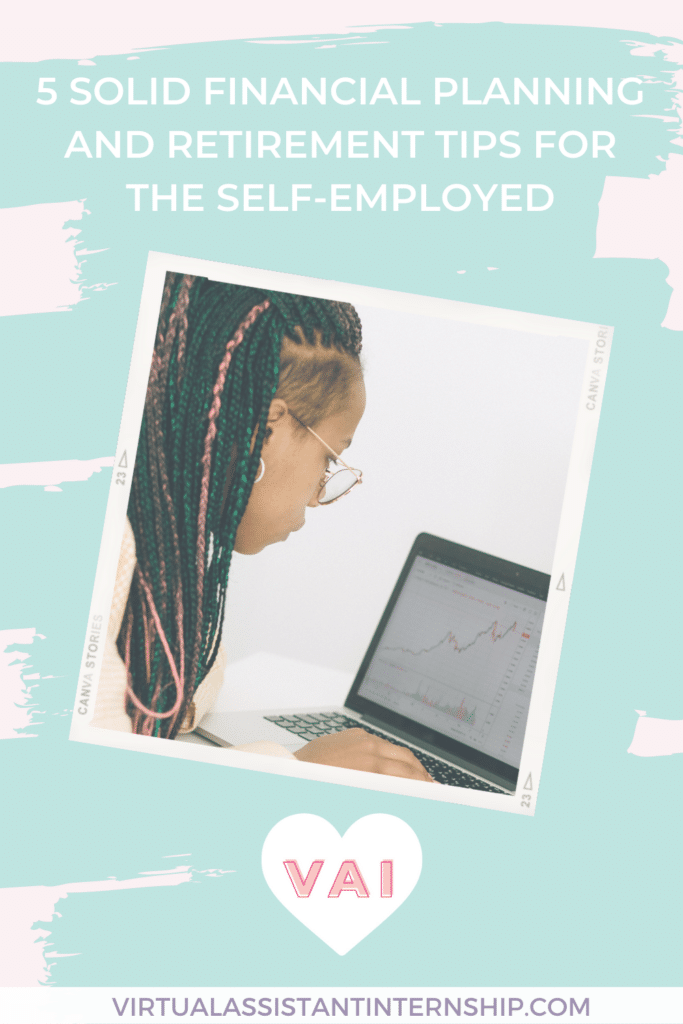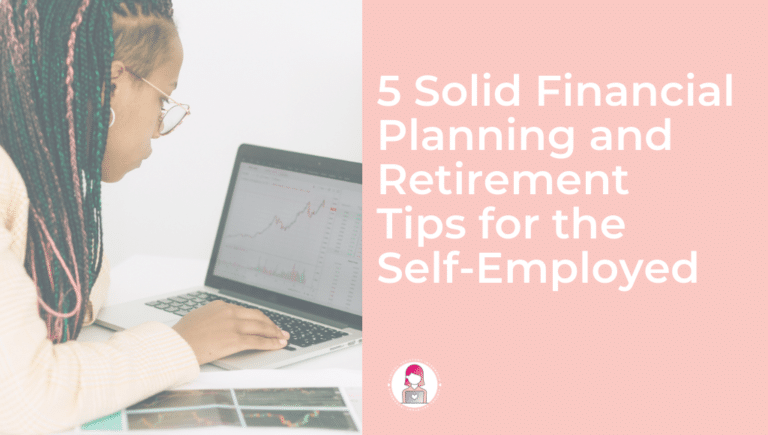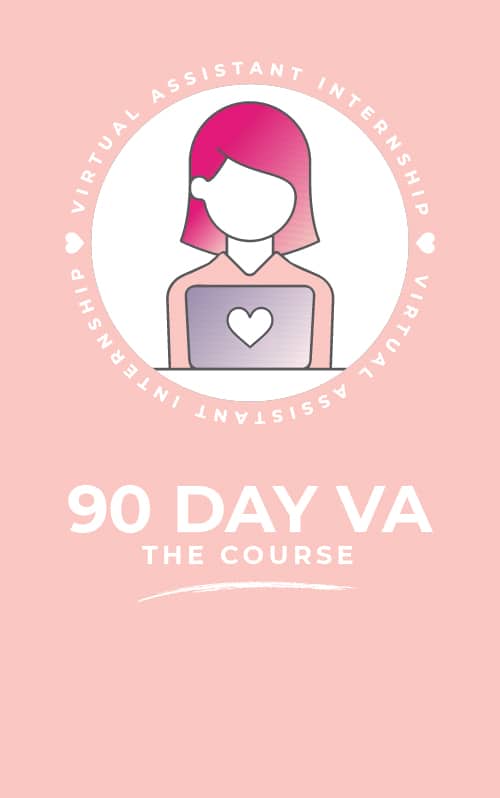When you start to work for yourself and step into your power as a solopreneur, it means that the conventional ‘9 to 5’ employer-provided retirement plans are no longer there. Preparing for retirement on your own can feel overwhelming, and frankly, terrifying! If you’re like I was in the beginning, you may have no idea what your options are, and maybe even feel like you are starting too late. Eeeek!
Well, I’m here to let you in on a secret: you DO NOT need an employer to provide anything for you to secure a bright financial future.
I hear this all the time: “What about retirement? I’m not sure this virtual assistant career is right for me…” And I end up laughing because not only was your company not doing that much for you anyway, but you have SO MANY options available to you as a self-employed virtual assistant!
It doesn’t matter if you are starting with zero financial experience! You are a resourceful solopreneur; with the right strategies, you can turn your profits into money that is working for you, because we both know you work hard enough!
Here are 5 solid financial planning and retirement tips for the self-employed.
*Disclaimer: The advice in this blog is directed towards US citizens — If you are outside the USA, please research the types of accounts that correspond to the ones mentioned here, in your own country!*

#1: Start Where You Are
Let’s start with what most of us in the United States are familiar with. Most companies offer their employees a 401K – a container for your money that gives you investment options.
There are two kinds of 401K – the traditional tax-deferred 401K, where the money grows and is taxed later, and the ROTH 401K, where you pay tax upfront, but are not taxed on the growth of your investments. Both types are seen as benefits provided by employers to employees.
But NEWSFLASH!
Unless your employer is matching your contributions, all they are actually DOING for you is completing the 401K paperwork and setting up auto-deductions. You can EASILY do the same thing for yourself, with an IRA (Individual Retirement Account). If you have your own business, you can set this up for yourself. You can even roll your existing 401K into a traditional IRA account when you make the move to self-employment.
You should 100% consult with a tax advisor because you can have a LOT of different accounts going on, growing your money for you while you work! One thing is for sure:
You DON’T need a finance degree to understand how these accounts work and then automatically move the money every month!
#2: You Have Options!
Here are just some of the options available to you:
- Stocks: Owning a stock means you own a fraction of a company. Stocks have an ascribed value, which can go up or down. But generally, stocks tend to go up long-term. Since 1928, the S&P 500 (a collection of the 500 largest stocks in the U.S) has averaged roughly 7% annual returns, even after adjusting for inflation. When you own stock in a company, you get a vote in that company’s annual meeting.
- ETF (Exchange Trade Funds) & Mutual Funds: For these funds, you own a fraction of a group of companies. These vary in size from large to small and can either be dividend-paying or reinvesting dividends. For ETFs, the value moves up and down every second, while mutual funds’ value moves up or down at the end of each trading day.
TO CLARIFY: you DO NOT have to set this all up and suddenly become some kind of expert day-trader!
All YOU have to do is:
- Set up an account on Schwab or Fidelity.
- Tell them you want to open a mutual fund.
- Tell them how much and how often you want to contribute funds.
- Specify how aggressively you want them to invest your money.
THAT’S IT! DO NOT GET FREAKED OUT. Once your account is set up, everything else is taken care of FOR YOU! It is SO easy once you figure out it isn’t hard.

#3: Consider a SEP Account
I was told early on to set up a Simplified Employee Pension Account (SEP). SEP accounts are for individual business owners. They have some great tax advantages and are low-cost. You can potentially put even more of your profits into it — but again, I strongly advise everyone to get proper financial advice based on YOUR unique situation.
Full disclosure: I didn’t even open a SEP account until I made over 60K a year. My CPA was the one who let me know how it could benefit me at tax time, and exactly how much I should be putting away per year to maximize my tax advantages! So don’t freak out — there are professionals out there who help solopreneurs like you every single day.
#4: Better Late Than Never
If you feel like you have put off starting to save for your retirement too long, know that you are not alone!
There are tons of reasons why you may be only now ready to invest: Maybe you are in your 30s and just building your own Virtual Assistant business now; maybe you were a stay-at-home mom and didn’t have your own income; maybe you have been stuck paying off your student loans. Whatever the reason, I am here to tell you that it is NEVER TOO LATE to start investing for your retirement.
Here is what I want you to know:
- The best time to start investing is TODAY! The second best time to start investing is TOMORROW! Do not beat yourself up for time lost; we can’t change the past. The best thing you can do is let all that guilt go.
- You are never going to feel completely ready. Don’t play the “Analysis Paralysis” game where you spend so much time thinking and researching that you never take that 1st step. Just get started!
- If you make a mistake, it is STILL your money— you have nothing to lose. Open the account, set it to AUTO-INVEST, and BOOM: you’re on your way!
- It doesn’t matter how little you have to contribute each month; you are more resourceful than you know and you can find a way to make it work.
Luckily, many of us still have time to plan for retirement, even if we are starting late. The benefit of having more time for your money to grow is that you can benefit from the magic of compounding!
Think of compounding interest as interest on interest: whenever your investment generates interest, that interest is then reinvested onto your total principal sum. Over time, this snowballs your total investment, meaning the longer you keep your money invested, the more compound interest you will add onto your total amount.
That means that even if you have less-than-stellar years, starting early will still catch you up in the long run!
This is why you don’t put your hard-earned money in a simple savings account. Let an investment account grow your money for you.

#5: Define YOUR idea of success
Finally, this is something I am so passionate about.
I hear from people all the time who have no idea what the term ‘early retirement’ even means, and what it would take, in money and time, to get there. People will think, “if only I could retire young…” or even “if only I could retire…” but yet tend to avoid the topic of how to get to where they want to go!
I encourage everyone to take the time to dig deep, and determine what success looks like TO YOU:
- What would being wealthy look like?
- What would it take to retire at the standard you desire?
- What does the lifestyle you want cost?
- What does the lifestyle you have now cost?
This process will take some time, but once you figure out where you are, where you want to go, and how many years you have to get there, you can determine what your monthly contributions should be. Then, simply AUTOMATE IT!
If you are serious about taking control of your financial future, do yourself a favor and take the time to figure this out for yourself. Then you are in a much better position to figure out HOW you will set yourself up for a secure future of your own choosing.
Will it be by:
- Investing in assets that appreciate over time?
- A stock portfolio that generates dividends?
- Maybe you want the ability to pull X amount of dollars a year from your investment portfolio?
You can tweak this as you go, and as you become more successful! Planning in this way makes the future tangible and gives YOU the power.
Here is what I would like you to do:
- Figure out your number to save for retirement, and
- Set up an account.
- Look into the different options: IRA, mutual and ETF funds, SEP, 401K and decide which one is best for you.
- Set up your auto-deduction.
- Come tell me about it on Instagram!
Most of all, know that you have everything you need to take control of your financial future. Don’t be overwhelmed or confused about getting started any longer!
Take pride in your 1st step towards becoming a financially independent business owner! My course, 90 Day VA, teaches you all the skills you’ll need to launch a successful career as a Virtual Assistant. Check out my FREE masterclass to learn more!

In 90 Day VA, Esther teaches her students how to research and repurpose current content into blogs for the VAI website. Lisa is the student we’ve chosen this week to feature what she’s learned in the course. Get to know her:

Lisa Baskin is a virtual assistant here to make your life easier so you can DO YOU! When she’s not helping online business owners, she loves to play music and hike Vancouver Island. She’s a member of 90 Day VA and can help with everything from email management, ghostwriting writing, all things social media, and more! To see all the services she offers and how she can help you, check out her Facebook Page.



